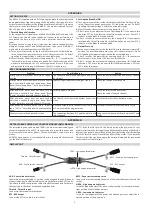
Page
120
7.5
FloCalR (Return Fuel Flow Calibration)
This entry adjusts the scaling of the return fuel flow sensor. It is not used unless your fuel system
requires monitoring the outgoing and return fuel, using two fuel flow sensors. If only one flow sensor
is used, this setting is ignored, and will not affect the fuel flow calculation.
To adjust this setting for dual fuel flow installations, use the following procedure:
1) Set FloCalR to zero.
2) Turn on the electric fuel pump (with the engine not running), and verify a non-zero fuel flow
reading is displayed. Increase the value of the FloCalR in steps. As this setting is increased, the
displayed fuel flow should drop. Continue to increase this setting until the displayed fuel flow just
becomes zero. Use the lowest setting that results in a zero fuel flow display. A typical setting for this
entry is 128, but could vary by +/- 30%.
7.6
TachP/R - Setting for Correct Tachometer Readings
The EIS employs a sophisticated method of measuring engine RPM to provide 10 RPM resolution
independent of the number of pulses per revolution of the engine. To provide this flexibility, the
TachP/R is set to a code corresponding to the number of pulses the instrument detects per revolution of
the engine. To set this correctly for your engine, first determine how many pulses per engine
revolution will be generated, according to the following paragraphs, and set the TachP/R as indicated
by the TachP/R table. (The tachometer can not measure RPM from analog outputs that encode RPM as
a voltage level. This type of tachometer output is rare.)
Two inputs are provided to allow sensing the engine RPM from either of two sources. The EIS will use
tachometer input 1 when a tachometer signal is sensed. If tachometer input #1 is not providing any
RPM indication, the EIS will use tachometer input #2.
Each tachometer input has a corresponding TachP/R setting allowing them to be independently
configured. This allows the use of two dissimilar tachometer inputs, such as a magneto and an
electronic ignition input. The settings are identified as Tach1P/R and Tach2P/R, corresponding to each
of the inputs.
CAUTION:
If there is any doubt about the accuracy of the tachometer reading, verify the reading using another
tachometer. Attempting to take-off with less than full power can be very dangerous. In general, if the EIS
tachometer reading is not erratic, and the TachP/R setting is correct, the tachometer will be accurate to 5 RPM.
7.6.1
Tach Connections to Magneto P-leads, Ignition Coils or Tach Outputs
These types of tachometer connections typically generate one pulse for every, or every other, spark
plug fired per revolution of the engine. Thus 4-cylinder engine will have 1 or 2 pulses per revolution,
while a 6-cylinder, 4-stroke engine will have 1.5 or 3. If you choose the wrong setting the tachometer
reading will be off by half or double the actual RPM. A 27 k Ohm resistor must be connected between
the instrument and the mag P-lead as shown in figure 7 to protect the mag from being turned off by a
failure in the instrument.
A magneto or ignition test is commonly performed before each flight for airplanes that include dual
ignition systems. This test requires turning off each ignition system, and verifying that the engine will
function on the remaining ignition system. Two tachometer inputs are provided to allow sensing the
engine RPM from either of two ignition systems so that the RPM indication is not lost during the
magneto test.. The EIS will use tachometer input 1 when a tachometer signal is sensed. If tachometer
input #1 is not providing any RPM indication, the EIS will use tachometer input #2.
Summary of Contents for 912 Dragonfly
Page 3: ...Page 2 ...
Page 4: ...Page 3 ...
Page 5: ...Page 4 ...
Page 25: ...Page 24 Drawing 1 ...
Page 27: ...Page 26 Drawing 2 ...
Page 29: ...Page 28 Drawing 3 ...
Page 31: ...Page 30 Drawing 4 ...
Page 33: ...Page 32 Drawing 5 ...
Page 35: ...Page 34 Drawing 6 ...
Page 37: ...Page 36 Note for Hydraulic Brakes see Appendix B Drawing 7 ...
Page 39: ...Page 38 Drawing 8 ...
Page 41: ...Page 40 Drawing 9 ...
Page 43: ...Page 42 Drawing 10 ...
Page 45: ...Page 44 Drawing 11 ...
Page 47: ...Page 46 Drawings 12A 12B ...
Page 49: ...Page 48 Drawing 13 ...
Page 51: ...Page 50 Drawing 14 ...
Page 53: ...Page 52 Drawing 15 ...
Page 55: ...Page 54 Drawing 16 ...
Page 57: ...Page 56 Drawing 17 ...
Page 59: ...Page 58 Drawing 18 ...
Page 61: ...Page 60 Drawing 19 ...
Page 63: ...Page 62 Drawing 20 ...
Page 65: ...Page 64 Drawing 21 ...
Page 67: ...Page 66 Drawing 22 ...
Page 69: ...Page 68 Drawing 23 ...
Page 71: ...Page 70 Drawing 24 ...
Page 73: ...Page 72 Drawing 25 ...
Page 75: ...Page 74 Drawing 26 ...
Page 77: ...Page 76 Drawing 27 ...
Page 79: ...Page 78 Wiring1 jpg Drawing 28a ...
Page 80: ...Page 79 Wiring2 jpg Drawing 28b ...
Page 81: ...Page 80 elecLights jpg Drawing 28c ...
Page 83: ...Page 82 Drawing 29 ...
Page 85: ...Page 84 Drawing 30 ...
Page 92: ...Page 91 Appendix B Brakes Manual for BX1320 BX1000 Appendix B Page 1 ...
Page 93: ...Page 92 Appendix B Page 2 ...
Page 94: ...Page 93 Appendix B Page 3 ...
Page 96: ...Page 95 Appendix B Page 5 ...
Page 97: ...Page 96 Appendix B Page 6 ...
Page 98: ...Page 97 Appendix B Page 7 ...
Page 104: ...Page 103 Figure 1a Description of Display Pages ...
Page 105: ...Page 104 Figure 1b Description of Display Pages ...
Page 138: ...Page 137 Appendix C EIS 4000 912 914 ...
Page 139: ...Page 138 Appendix C EIS 4000 912 914 ...
Page 140: ...Page 139 Appendix C EIS 4000 912 914 ...
Page 141: ...Page 140 Appendix C EIS 4000 912 914 End Appendix C ...
Page 155: ...Page 154 Appendix E2 Powerfin Prop Page 2 ...
Page 156: ...Page 155 Appendix E2 Powerfin Prop Page 3 ...
Page 157: ...Page 156 Appendix E2 Powerfin Prop Page 4 ...
Page 158: ...Page 157 Appendix E2 Powerfin Prop Page 5 ...
Page 159: ...Page 158 Appendix E2 Powerfin Prop Page 6 ...
Page 160: ...Page 159 Appendix E2 Powerfin Prop Page 7 ...
Page 161: ...Page 160 Appendix E2 Powerfin Prop Page 8 ...
Page 162: ...Page 161 Appendix E2 Powerfin Prop Page 9 ...
Page 163: ...Page 162 Appendix E2 Powerfin Prop Page 10 ...
Page 164: ...Page 163 Appendix E2 Powerfin Prop Page 11 End of Appendix E2 ...
Page 187: ...Page 186 By Memphis Soaring FIGURE 3 Common Signals ...















































